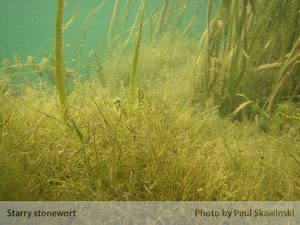Wisconsin DNR Unveils Draft Strategy for Aquatic Invasive Species
What Do You Think? DNR Accepts Public Comments Through Aug 31
By Michael Engleson, WI Lakes Executive Director
August 9, 2018
Starry Stonewort in the southeast. Zebra mussels encroaching on the northwest. Eurasian Watermilfoil a constant irritant to lakes across the state. Aquatic invasive species (“AIS”) like these are a scourge on lakes, rivers, and wetlands – overrunning natural ecosystems, often negatively impacting property values, and hampering recreational activities (and the economic benefits they bring).

Photo courtesy WDNR
Wisconsin’s existing strategic plan to deal with these “invaders” dates back to 2003, and recently the Department of Natural Resources (DNR) released a draft revision to the plan that was developed in consultation with a core team of Wisconsin stakeholders that are impacted by aquatic invasive species, including the University of Wisconsin-Extension, county aquatic invasive species staff, not-for-profit groups such as Wisconsin Lakes and the River Alliance of Wisconsin, and multiple sections of DNR staff including lakes and rivers, fisheries, and law enforcement.
“Since the original version of the plan was approved, we have new species that we are concerned with, new pathways of invasion in Wisconsin, and new tools to help us manage the undesirable impacts of aquatic invasive species,” says Tim Campbell, an outreach specialist for the University of Wisconsin-Extension and Wisconsin Sea Grant and lead author of the plan. “We want to make sure we have incorporated the new approaches and concerns into our management plan so that we use the most effective methods possible.”
While the new plan retains the state’s original strategy to (1) prevent the spread of AIS into Wisconsin, (2) contain the spread of AIS within the state, and (3) control existing populations of AIS to minimize harmful impacts, the new strategy implements an approach that
organizes strategies and actions by “invasion pathway”. Pathways are the ways AIS arrives in and is spread about the state. The plan identifies seven pathways, which include:
- Maritime Commerce
- Canals, dams, and diversions
- Recreational activities and service providers
- Non-recreational fishing and aquaculture
- State and federal agency activities
- Transportation and utility corridors
- Organisms in trade (e.g. species sold through the internet)
The plan goes on to identify specific examples within each pathway and offers strategies for dealing with each.
 In addition to working with stakeholders on drafting the plan, DNR is soliciting public comments through Aug. 31. More information on the plan and how to comment can be found on the DNR website (scroll down to the table, and the AIS plan draft is the first item). Comments will be reviewed and addressed by DNR staff and those responses will be released with the final version of the management plan.
In addition to working with stakeholders on drafting the plan, DNR is soliciting public comments through Aug. 31. More information on the plan and how to comment can be found on the DNR website (scroll down to the table, and the AIS plan draft is the first item). Comments will be reviewed and addressed by DNR staff and those responses will be released with the final version of the management plan.
“The AIS Management Plan is a valuable planning and implementation tool in Wisconsin’s efforts to prevent, contain, and control the spread and impacts of AIS,” says Bob Wakeman, aquatic invasive species program coordinator for the Wisconsin DNR. “Having the comments and buy-in from all stakeholders can increase the efficacy of this plan and can help us all take effective actions to manage the impacts of aquatic invasive species in Wisconsin.”
Wisconsin Lakes is pleased to have participated in the process to develop a new state-level strategy for dealing with AIS. We encourage our members to thoughtfully review the plan and submit comments to the department. AIS is an issue that is faced by all of the lakes community, and working together we can improve on Wisconsin’s successes and overcome our deficiencies in preventing, containing, and controlling the spread of AIS. An important piece of that effort starts with your voice being heard on this revision to statewide strategy.

